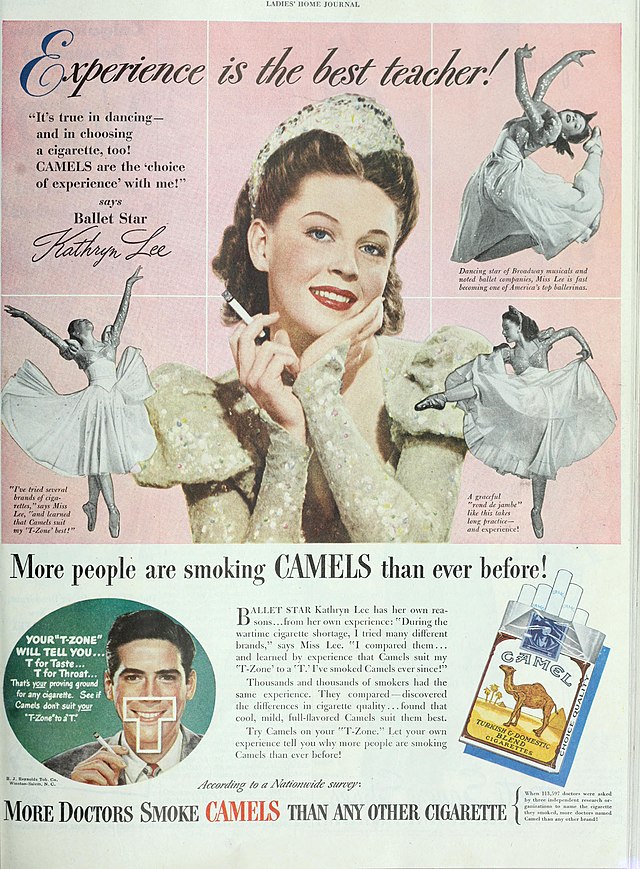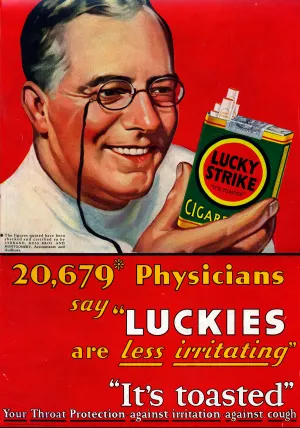Smoking History - Cigarette Companies Used Doctors For Promotion
Before it was discovered that cigarettes cause cancer, tobacco companies recruited members of the medical profession to appear in their advertisements.
Author:Suleman ShahReviewer:Han JuDec 29, 202253 Shares1.1K Views

Smoking History- Before it was discovered that cigarettes cause cancer, tobacco companies recruited members of the medical profession to appear in their advertisements. For a long time, physicians were considered the ultimate authority on health. Patients placed their faith in their physicians' knowledge and experience, and for the most part, they listened to their recommendations.
When public health concerns about cigarette smoking began to gain notice in the 1930s, tobacco firms acted swiftly to address the situation. They used the people's faith in physicians to assuage fears about the risks of smoking among the general population. As a result, physicians' usage in cigarette commercials came to be.
Association Of Doctors With Tobacco Companies And Tobacco Advertising
Doctors smoked cigarettes throughout the 1930s and 1940s because they didn't know smoking caused lung cancer. Smoking causes slight throat discomfort, according to tobacco firms. As a result, tobacco corporations utilized physicians' authority to bolster their claims regarding their products.
Cigarettes being marketed as healthy (even to children and pregnant women) by doctors may seem shocking to today's reader. But there was no proof that smoking was harmful before 1950. A rising death rate from lung cancer prompted concern in the 1940s, says Martha Gardner, historyand social sciences professor at Massachusetts College of Pharmacy and Health Sciences. “People were concerned, but they didn't know it was cigarettes.” Yes, smokes irritated the throat. But firms exploited this to sell their products better. It wasn't all smokes that were bad; it was simply those.
American Tobacco, the producer of Lucky Strikes, was the first to utilize doctors in cigarette commercials. "LUCKIEST are less unpleasant to the throat," it said in a 1930 ad. According to the company's ad agency, “fair many people” had previously indicated Lucky Strikes were less irritating to sensitive and fragile throats than other cigarettes. Unsurprisingly, many physicians agreed, and Lucky Strike exploited their responses to indicate their smokes were healthier for your throat.
In a 1937 Saturday Evening Post commercial, physicians claimed that “when smokers switched to Philip Morris, every incidence of irritation cured entirely and improved.” It didn't say that Philip Morris backed the physicians.
Philip Morris continued to promote “studies” it financed until the 1940s when penicillin was introduced. “The American public views medicine and sciencepositively,” adds Gardner. He co-authored an AJPH essay on doctors in cigarette marketing. “Framing things that way appears to assist people.” A Medical Relations Division was developed and marketed in medical publications by R.J. Reynolds Tobacco.
Then, like Philip Morris, Reynolds began paying for research. “More doctors smoke Camels than any other cigarette,” Reynolds advertised in 1946. For this “finding,” they gave doctors complementary Camel cigarettes and asked what brand they smoked. When tobacco corporations faced proof that their products caused lung cancer in the mid-1950s, their marketing techniques shifted.
According to Gardner, “all the cigarette corporations kind of work together to push the concept that...we don't know yet if it's harmful.” “A Frank Statement to Cigarette Smokers,” said that studies linking cancer and smoking were worrisome but inconclusive. So the firms formed a study group to look into it.
After that, physicians were no longer credible in cigarette advertising. In 1964, the US Surgeon General reported that smoking caused lung cancer, laryngeal cancer, and chronic bronchitis. Until 1998, the tobacco industry maintained “controversy” over whether cigarettes were healthful. That year, a lawsuit settlement abolished the Tobacco Institute and the Committee for Tobacco Research.
Tobacco corporations jumped into vapingas soon as e-cigarettes hit Europe in 2006. The FDA stated in 2018 that teen vaping was expanding alarmingly, raising concerns about teen nicotine addiction. In 2019, six people died from vaping-related lung diseases. The FDA plans to remove flavored e-cigarettes from the market by September 2019.
Did Doctors Use To Recommend Cigarettes?
From the 1930s through the 1950s, “doctors recommend” combined the world's most lethal consumer product. Smokers coughed when they smoked cigarettes back then. According to tobacco companies' throat “doctors,” who wore white coats, a shortage of menthol or dust was blamed, not the cigarettes themselves.
Physicians were not immune to the addictions to cigarettes and tobacco products, and tobacco corporations were well aware of this. Many doctors were still skeptical that there was a widespread link between smoking and illness. Instead, it was considered that smoking only harmed specific people's health; it was supposed to be a case-by-case matter.
Old Cigarette Ads With Doctors
In the 1920s, Lucky Strike dominated. The American Tobacco Company's brand was the first to feature a doctor's picture in its ads. “20,679 doctors believe ‘Luckies are less irritating,” its ads said. Lucky Strike gave physicians complimentary cartons of cigarettes to test for ‘sensitive and sore' throats as part of its marketing campaign. The manufacturer claimed toasting made its cigarettes smoother. Lucky Strike faced competitors by the 1930s. Physicians' study was referenced in a new Philip Morris commercial.
According to one commercial, giving Philip Morris smokes to people with sore throats "clears up totally or significantly improves." Tobacco giant Philip Morris became a prominent cigarette brand for the first time because of this series of ads.
The “More Doctors” campaign for RJ Reynolds Tobacco Company's Camels cigarettes was one of the most renowned of the era. According to a countrywide poll, “more doctors smoke Camels than any other cigarette!” these commercials stated. These commercials showed physicians in labs, desks, or talking to patients.
Companies wanted doctors to smoke their cigarettes, Jackler claimed. Phillip Morris and RJ Reynolds sponsored physicians' lounges and gave complimentary smokes at medical congresses. RJ Reynolds' Medical Relations Division was the most imaginative way to persuade physicians. With the help of researchers, this ‘division' promoted Camels cigarettes by proving the company's medical claims. Now the corporation may promote to both consumers and clinicians using study data.
These commercials began to show a change in the late 1940s and early 1950s. To test it for yourself, Camels began advertising. However, the commercials now encouraged buyers to try out the cigarettes for themselves. “I enjoyed the exam! So delicious!"
When Was Smoking Declared Harmful?
The Surgeon General's Advisory Committee on Smoking and Health delivered its first report on January 11, 1964. The Advisory Committee determined that cigarette smoking causes men's lung and laryngeal cancer, causes female lung cancer and is the primary source of chronic bronchitis. The report's release was the first in a sequence of initiatives taken more than 40 years later to improve Americans' health. Since then, people, business groups, government agencies, and elected officials have responded to the Advisory Committee's request for "proper corrective action."
There was a Federal Cigarette Labeling and Advertising Act of 1965 and the Public Health Cigarette Smoking Act of 1969.
- A warning on cigarette packs
- Cigarette advertising in the media is banned
- A yearly report on the health effects of smoking
The Public Health Service developed the National Clearinghouse for Smoking and Health in September 1965. The Clearinghouse and its successor, the CDC's Office on Smoking and Health, have produced 29 reports on the health effects of smoking.
The Public Health Service has supported effective state and local tobacco control initiatives, disseminated tobacco study findings, and ensured public awareness of anti-smoking messaging. In this changing social environment, more people are quitting smoking. Nearly half of adult smokers have stopped.
The anti-smoking campaign is a tremendous public health triumph with few precedents. Even though tobacco is addicting and huge economic factors promote its use, it succeeds. Efforts to broaden proven interventions must be maintained.

Suleman Shah
Author
Suleman Shah is a researcher and freelance writer. As a researcher, he has worked with MNS University of Agriculture, Multan (Pakistan) and Texas A & M University (USA). He regularly writes science articles and blogs for science news website immersse.com and open access publishers OA Publishing London and Scientific Times. He loves to keep himself updated on scientific developments and convert these developments into everyday language to update the readers about the developments in the scientific era. His primary research focus is Plant sciences, and he contributed to this field by publishing his research in scientific journals and presenting his work at many Conferences.
Shah graduated from the University of Agriculture Faisalabad (Pakistan) and started his professional carrier with Jaffer Agro Services and later with the Agriculture Department of the Government of Pakistan. His research interest compelled and attracted him to proceed with his carrier in Plant sciences research. So, he started his Ph.D. in Soil Science at MNS University of Agriculture Multan (Pakistan). Later, he started working as a visiting scholar with Texas A&M University (USA).
Shah’s experience with big Open Excess publishers like Springers, Frontiers, MDPI, etc., testified to his belief in Open Access as a barrier-removing mechanism between researchers and the readers of their research. Shah believes that Open Access is revolutionizing the publication process and benefitting research in all fields.

Han Ju
Reviewer
Hello! I'm Han Ju, the heart behind World Wide Journals. My life is a unique tapestry woven from the threads of news, spirituality, and science, enriched by melodies from my guitar. Raised amidst tales of the ancient and the arcane, I developed a keen eye for the stories that truly matter. Through my work, I seek to bridge the seen with the unseen, marrying the rigor of science with the depth of spirituality.
Each article at World Wide Journals is a piece of this ongoing quest, blending analysis with personal reflection. Whether exploring quantum frontiers or strumming chords under the stars, my aim is to inspire and provoke thought, inviting you into a world where every discovery is a note in the grand symphony of existence.
Welcome aboard this journey of insight and exploration, where curiosity leads and music guides.
Latest Articles
Popular Articles
